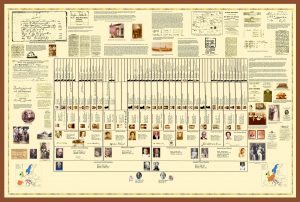Currently (slowly but surely) Brewing: May-June Issue of Digging History Magazine (Crazy in Colorado)
 Here’s a preview of the next issue of Digging History Magazine, “currently (slowly but surely) brewing”, with a focus on the great state of Colorado:
Here’s a preview of the next issue of Digging History Magazine, “currently (slowly but surely) brewing”, with a focus on the great state of Colorado:
- “Crazy in Colorado: Wheels in Their Heads and Other (Insane) Stories” is the lead-off article in the upcoming issue of Digging History Magazine (May-June) with a look at what it meant to be deemed insane (a “wheely citizen” as one newspaper called them) in the late nineteenth and early twentieth centuries.
- “Lightning Struck Twice: an en-lightning adventure in research” is one of my favorite kinds to write. When I take off on what I call my “adventures in research” I never know what I’ll find. This one started while researching my own family — just a little news item with an unusual (and incredulous) headline. Before I knew it I had a long and winding story which also includes a generous dollop of history of Leadville’s early years (without one mention of Baby Doe Tabor, I might add!).
- Praise the Lord and Place Your Bets: No doubt about it — Alice Ivers Duffield Tubbs Huckert was a one-of-a-kind character, better known as Poker Alice. Google “Poker Alice” and you’ll find any number of articles about her, although many of them contain inaccuracies. The best stories are the ones told in the first person. This article, a total re-write of the original Digging History blog post a few years ago, sets the record straight through the actual words and recollections of Poker Alice herself (and a few things she didn’t or wouldn’t discuss!).
- Colorado’s Glory Days: Boom Town to Ghost Town: A look at some of the towns which sprung up almost overnight in Colorado’s glory days of gold and silver rushes.
- OK, I Give Up . . . What is It? (The Publick Hath Need of It): With this column you never know what the topic will uncover. By necessity the pest house was among the first institutions established in a town. From Boston’s 1721 smallpox epidemic to San Francisco’s China Annie, the history of the pest house is an interesting (surprisingly so) one.
- Ways to (Fashionably) Go (or Stay) in Days of Old: This is an article I’ve wanted to write for some time. Like “Lightning Struck Twice” it all started after stumbling across some unusual nineteenth century headlines. “Saved by Her Corset” — what exactly did that mean? What I uncovered is what I like to call “it was a Victorian thing” — oh the things they decided to fume, fuss, feud and fight over!
- The Dash: Doc Susie, Medicine Woman: This article is another re-write of a popular article originally posted on the blog. Dr. Susan Anderson, better known as “Doc Susie” (and the likely inspiration for television’s Dr. Quinn, Medicine Woman” series) was another of those one-of-a-kind characters. A much beloved Colorado pioneer, she endured prejudice, her own health struggles, strained family relationships, broken engagements and more throughout her long and successful career as a mountain doctor.
Taking a little extra time to “brew” this issue will (hopefully) make for a more interesting and enlightening experience for readers! Can’t wait to publish it (hopefully on or before May 15)!
Sharon Hall, Publisher and Editor, Digging History Magazine
P.S. Not yet a subscriber? Now’s the time to sign up with the added bonus of a chance to win either a family history chart or a 10-hour block of research. Details here: https://digging-history.com/2019/04/13/digging-history-contest-win-a-10-hour-block-of-research-or-a-family-history-chart/
Digging History Contest: Win a 10-hour Block of Research OR a Family History Chart!
 Digging History is conducting a giveaway with two prize options this month to boost subscriptions for Digging History Magazine. The contest ends
Digging History is conducting a giveaway with two prize options this month to boost subscriptions for Digging History Magazine. The contest ends May 10 May 15 (extended for five days) and the rules are as follows:
Enter Online (by May 10 May 15)
Purchase a 3-month ($8), 6-month ($16) or 1-year ($32) subscription online by following these easy instructions:
- Go to: https://digging-history.com/digging-history-magazine-subscription/
- Select an option that best suits you (3-month, 6-month, 1-year)
- Purchase a subscription and receive TWO entries (a bonus for purchasing online).
Prefer to pay by check? No problem. Six-month and one-year subscriptions are available by check and will garner ONE entry in the contest. Contact me and I’ll send you details about how to pay by check and get your subscription started.
 Win a family history chart and redeem the prize whenever you’re ready to document your family history, OR . . .if you haven’t started your family history research, redeem the prize for a 10-hour block of genealogical research. Either way, it’s a BIG WIN worth up to $350!
Win a family history chart and redeem the prize whenever you’re ready to document your family history, OR . . .if you haven’t started your family history research, redeem the prize for a 10-hour block of genealogical research. Either way, it’s a BIG WIN worth up to $350!
Good luck!
Digging History Magazine – March-April 2019 Issue
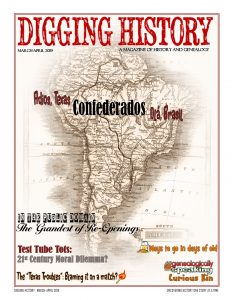 The March-April 2019 issue of Digging History Magazine features a variety of articles, although quite a few focus on the Civil War — one of them led to a little “adventure in research” for a family that appeared to have just disappeared after the 1860 census. Here is a summary:
The March-April 2019 issue of Digging History Magazine features a variety of articles, although quite a few focus on the Civil War — one of them led to a little “adventure in research” for a family that appeared to have just disappeared after the 1860 census. Here is a summary:
- Confederados: Adios, Texas! Ola, Brasil! – a look at a little-known piece of United States and Civil War history. Do you have ancestors who seem to have vanished following the Civil War? This article may provide some clues to finding them.
- Elusive Ancestors? Crack Open a History Book or Two (or Three) – The Confederados article led to an “adventure in research” and a lesson about not only looking for dates and records, but the history of the times your ancestors lived in.
- In the Public Domain: The Grandest of Re-openings – a look at the history of what we call the “public domain”, a concept enshrined originally in the United States Constitution. This year all materials published in 1923 will be moved into the public domain, next year 1924 and so on. What does it mean for finding digitized materials and gaining access?
- Genealogically Speaking: Curious Kin – The occasion of stumbling across some uniquely-named brothers inspired this story. One thing leads to another — what about the “Ocean Sisters” or “Thomas Jefferson Roach and His Sister Wives”. Bigger Head? Somebody was really named that (there’s a story!)?
- The “Texas Troubles”: Blame it on a Match? – The story of a little-known incident which could very well have set off the Civil War months before April 1861. The South was on edge already and a series of mysterious fires across Texas seemed rather suspicious.
- Speaking of Matches – a companion story about another kind of match — one that morphed into nineteenth century political name-calling. Sound familiar?
- Ways to Go in Days of Old – a new column which will highlight some of the common and not so common ways our ancestors died. This one is inspired by a Civil War Widow’s Pension Application.
- OK, I give up . . what is it? – another new column which highlights archaic terminology which one might come across in historical and genealogical research. For example, what is a hog reeve or “sessor” or pounder? Each played a significant role in the community life of early American towns and settlements.
- Test Tube Tots: 21st Century Moral Dilemma? – What if you took a DNA test and found out something rather shocking about who you were (and were not) related to? What would you do if you found out, for instance, the man you always considered your father wasn’t your biological father because you’d been conceived artificially (unbeknownst to you)? An interesting topic to explore in the world of rapidly advancing DNA technology.
- The Dash: William Henry Sallada – Part I of an extended article about a man who lost his sight during the Civil War and went on to live a long, full and purposeful life. Sometimes you run across stories that just beg to be old. This is one of those.
On sale in the magazine store or better yet, start a subscription (three budget-minded options).
Brothers: His Name is Spelled G-e-a-r-l-d (for good reason)
 When they were born over 83 years ago I’m not certain Hulon and Willie Hall knew my grandmother was carrying twins. They had already conceived (and lost) a set of triplets. It had been about seven years since my grandparents buried their first-born toddler son, Hulon Lamar, a tragic victim of an accidental shooting in a remote area of San Miguel County, New Mexico. Life had been tough enough and then it got tougher still.
When they were born over 83 years ago I’m not certain Hulon and Willie Hall knew my grandmother was carrying twins. They had already conceived (and lost) a set of triplets. It had been about seven years since my grandparents buried their first-born toddler son, Hulon Lamar, a tragic victim of an accidental shooting in a remote area of San Miguel County, New Mexico. Life had been tough enough and then it got tougher still.
The nearest “town” was the Garita Post Office, so that’s where their birth certificates state they were born. However, the place where they were born, a humble prairie dwelling, bespeaks the life and times they were born into — the hardscrabble life of a farm and ranch family trying to eke out a living during the Great Depression.
 I’ve heard Aunt Joy tell the story many times of how my grandfather assigned names to the twins. Hulon Hall pondered the situation thoughtfully and purposefully. They weren’t identical twins, yet distinctly different, and came into the world about five minutes apart. Although the first would always say he was the “big brother” he was the smallest. After careful consideration it was decided the names would be assigned thusly: the little one would be Earl D. and the bigger one Gearld E. No middle names, just initials. Not exactly unusual, but meaningful nonetheless. Why is that?
I’ve heard Aunt Joy tell the story many times of how my grandfather assigned names to the twins. Hulon Hall pondered the situation thoughtfully and purposefully. They weren’t identical twins, yet distinctly different, and came into the world about five minutes apart. Although the first would always say he was the “big brother” he was the smallest. After careful consideration it was decided the names would be assigned thusly: the little one would be Earl D. and the bigger one Gearld E. No middle names, just initials. Not exactly unusual, but meaningful nonetheless. Why is that?
My Dad (the bigger one) has always had issues with the spelling of his name — not him personally, but how the world thinks his name should be spelled. Some record his name as “Gearld E.” (the legal one), but more often than not as “Gerald E.” Granted, the second is how everyone thinks the name should be spelled — it is, after all, the most common spelling and pronounced “jer–uh ld“. He signs his name based on the spelling on the document he’s signing, yet when saying his name pronounces: beginning as a “J sound” followed by “earl” with a “d” at the end — Gearld.
Do you see it (can you hear it)? Was my grandfather prescient? Earl D. would irrevocably be part of Gearld E. The two were meant to be part of one another, even their names. Prescient or not, so it has been. As one cousin wrote, “Oh the love between the two and the adventures they shared!”
The picture of Gearld E. holding the hand of his brother is poignant for us all as Earl D. is nearing the end of his life’s journey. My Dad has his own challenges and struggled with making the trip to see his brother. I’m proud (and grateful) he nevertheless made the difficult choice because I know how much it means to Uncle Earl. Tomorrow they will be joined by their “big sister”, our beloved 91 year-old Aunt Joy. They are the remaining children of Hulon and Willie (Strickland) Hall. Too soon we fear they will all be gone and we’ll be left with only memories, but what great ones they are!
The world may spell it “G-e-r-a-l-d” but for those of us who know and love them most it will always be “Earl D.” and “Gearld E.” (for a very good reason, you see).
Postscript: On March 3, 2019 Earl D. fell into a coma and passed away peacefully on the evening of March 4. R.I.P. Uncle Earl. On March 17, 2022 Gearld E. went peacefully into the arms of Jesus. No more pain! I love you Daddy!
Celebrating Family History
 Believe it or not, summer will be here soon. I know, I know. Many of us have been dealing with polar vortexes, epic winter weather events and more. Take heart — it will warm up soon!
Believe it or not, summer will be here soon. I know, I know. Many of us have been dealing with polar vortexes, epic winter weather events and more. Take heart — it will warm up soon!
Historically, one of many summertime traditions is the family reunion. Some are small, while others bring together extended family members from far-flung places around the country (or the world). If you’ve researched your family history and don’t yet have a chart which highlights your family’s unique history, Digging History is offering a great deal.
Digging History specializes in genealogical research and also provides custom-designed charts for its research clients or those who have done their own research and now want to preserve it in a unique way. I recently designed a chart for someone who had been researching for forty years (begun as a high school project)!
I strive to make each chart unique because each family history is unique. A chart will, of course, include pictures, names and dates. What makes a chart unique, however, are things like ancestor signatures, cattle brands, news clippings, patents, historical records and more. Each of these items is formatted to blend with the chart background and not merely pasted onto the chart. Here are some samples:
 Andrew Kent is this client’s sixth great grandfather. Andrew Kent holds a special place in Texas history, giving his life at the Alamo on March 6, 1836.
Andrew Kent is this client’s sixth great grandfather. Andrew Kent holds a special place in Texas history, giving his life at the Alamo on March 6, 1836.
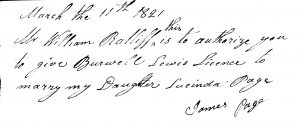 A father’s permission for his daughter to be married.
A father’s permission for his daughter to be married.
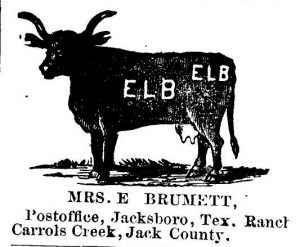 My third great-grandmother’s cattle brand.
My third great-grandmother’s cattle brand.
A special offer is running from now until June 30, 2019. These charts, as you might imagine, take time to plan and design (various sizes, number of generations and designs available), so contact me sooner rather than later. Once the chart is designed you own it and may have as many copies printed and distributed to family members as you like (splitting the cost among family members makes it very affordable!). Charts can be printed affordably at places like Walgreens and Costco. Contact me: [email protected] or 806-317-8639 for more details.
Sprucing Up a Bit
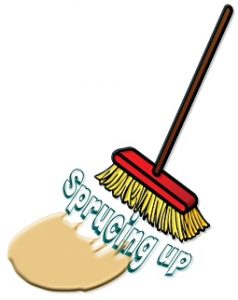 The closer we get to Spring the more our thoughts (may) turn to a bit of “Spring cleaning”. Some things just can’t wait that long, however. I decided to do a little “sprucing up” around the Digging History web site this week. The newly redesigned site is up and running, complete with a store for Digging History Magazine (and a budget-minded way to purchase a monthly genealogy research subscription, I might add).
The closer we get to Spring the more our thoughts (may) turn to a bit of “Spring cleaning”. Some things just can’t wait that long, however. I decided to do a little “sprucing up” around the Digging History web site this week. The newly redesigned site is up and running, complete with a store for Digging History Magazine (and a budget-minded way to purchase a monthly genealogy research subscription, I might add).
I cleaned out some obsolete stuff and spiffed up the blog a bit by adding back some stories I had previously taken down. From time to time articles will be taken down and undergo a complete re-write with new research, footnotes and sources, and be published in Digging History Magazine, a bi-monthly publication available by individual issue purchase or subscription. A good example of a more extensive (and abundantly more interesting) story was that of Nellie Ross Cullens-Norwood.
 The original article was one of the first “Tombstone Tuesday” articles I wrote back in 2013, and interesting enough after I decided to cast my search for a Find-A-Grave entry to the far reaches of Alaska, near the Arctic Circle. I found an entry with a small metal plaque of a woman in her late 70s buried in a small cemetery in Circle, Alaska. I figured there had to be a story — I was right. I decided to do more research and include Nellie’s story in “The Dash” column (the magazine’s version of “Tombstone Tuesday”) for the August 2018 issue. That issue highlighted characters and events of the Klondike and Alaskan gold rushes of the late nineteenth and early twentieth centuries.
The original article was one of the first “Tombstone Tuesday” articles I wrote back in 2013, and interesting enough after I decided to cast my search for a Find-A-Grave entry to the far reaches of Alaska, near the Arctic Circle. I found an entry with a small metal plaque of a woman in her late 70s buried in a small cemetery in Circle, Alaska. I figured there had to be a story — I was right. I decided to do more research and include Nellie’s story in “The Dash” column (the magazine’s version of “Tombstone Tuesday”) for the August 2018 issue. That issue highlighted characters and events of the Klondike and Alaskan gold rushes of the late nineteenth and early twentieth centuries.
The original article, admittedly, contained many “unknowns”. The 2018 article was enhanced by new research and answers to many gaps in Nellie’s story. More digging and a fair amount of newspaper research revealed more about the possible “why’s” of an aged Nellie living by herself, far away from family. For a genealogist, these types of discoveries are pure gold. Speaking of “genealogical gold”, that particular issue featured another article, entitled “Mining Genealogical Gold: Bed and Board Notices (he said, she said)”, an entertaining article about the ways husbands and wives had it out in newspapers by posting “bed and board” notices. Back and forth they went with what we today might call a “Tweetstorm”.
Speaking of sprucing up, every good genealogist should do a little house-cleaning or “leaf-raking” now and then. The October 2018 issue features an article, entitled “Genealogically Speaking: It’s Time to Rake the Leaves”, which explains some of the rather dubious “leaf hints” we all see on Ancestry.com. Some simply are not to be trusted, while others should be used with an abundance of caution. That issue also included some previous blog articles cobbled together for an article, entitled “Are You One of Those Kind of People?” (referring to people who love to snoop around old cemeteries, bwahaha!).
 Some might wonder why I now require payment for stories (via individual issue purchase or subscription) which I formerly wrote for free. That’s a good question. Many, many (many!) sites like this one appear to freely publish articles, but may utilize ad-targeting campaigns (unbeknownst to the reader) or include super-annoying ads on their sites in order to monetize the blog. I, on the other hand, have a strong aversion to such tactics, especially the super-annoying ads (as I’m sure you’re aware, some of them are downright disgusting!). I don’t like them and I don’t think readers like to be bothered with them either. These types of tactics lead to an increase in your email spam, among other things.
Some might wonder why I now require payment for stories (via individual issue purchase or subscription) which I formerly wrote for free. That’s a good question. Many, many (many!) sites like this one appear to freely publish articles, but may utilize ad-targeting campaigns (unbeknownst to the reader) or include super-annoying ads on their sites in order to monetize the blog. I, on the other hand, have a strong aversion to such tactics, especially the super-annoying ads (as I’m sure you’re aware, some of them are downright disgusting!). I don’t like them and I don’t think readers like to be bothered with them either. These types of tactics lead to an increase in your email spam, among other things.
I expend a lot of time and effort researching, writing, editing and publishing the magazine because I want to share my passion for history and genealogy. I would also like to receive some remuneration for my efforts — the good old-fashioned way by earning it without all the machinations of Internet ad-targeting and such. If you sign up to either follow this blog or become a magazine subscriber, you will never see anything in your inbox that isn’t related to this site (as in, I “sold” your information to someone else). Ain’t gonna happen!
Back to “sprucing up”. Wouldn’t you just know it, there’s a history of the phrase! I’ve recently taken to pondering these types of things and introduced a new column: “Everything Has a History, Even …..” According to one source the term “spruce up” may have first been used in the late sixteenth century with the express purpose of referring to tidying up a bit: [You shall] spend a whole twelue month in spunging & sprucing.1
Sprucing up is done (maybe a little “spunging”) . . . time to get back to work researching, writing, editing and publishing the March-April issue. Stay tuned!
Sharon Hall, Genealogist & Publisher and Editor, Digging History Magazine
P.S. A free issue (“try-before-you-consider-buying”) is available to all who sign up to follow the blog. See the area in the upper right-hand corner of this page to do so.
Footnotes:
January 16, 1919: Hell for Rent – A Nation Goes Dry
 It finally happened on January 16, 1919. Church bells rang across America as the state of Nebraska voted to seal ratification of the 18th Amendment to the United States Constitution. The United States, the “first great nation to go dry” was about to enter a new era.
It finally happened on January 16, 1919. Church bells rang across America as the state of Nebraska voted to seal ratification of the 18th Amendment to the United States Constitution. The United States, the “first great nation to go dry” was about to enter a new era.
No Prohibitionist was more ecstatic than Evangelist William Ashley “Billy” Sunday.
NOW HELL WILL BE FOR RENT — BILLY SUNDAY
By REV W.A. SUNDAY
Richmond, Va, Jan 16 – The rain of tears is over. The slums will soon be a memory; we will turn our prisons into factories, our jails into storehouses, and corn cribs. Men will walk upright. Now women will smile, children will laugh, Hell will be for rent.
If any State fails to ratify the amendment, the star in the flag that represents it should be draped in mourning.
Uncle Sam’s knockout blow that sent the Kaiser and his Junker gang of cut-throats and John Barleycorn and all his cohorts to the mat for the count makes me more proud than ever that I am an American and have lived to see this day.1
So sermonized Billy Sunday in newspapers across America as “the last nail was driven into the coffin of King Alcohol.”2
Instead of “heaven on earth”, hell wouldn’t be “for rent” as Sunday proclaimed. Rather, all hell would break loose in the form of bootlegging, moonshine and a level of lawlessness never before seen in America.
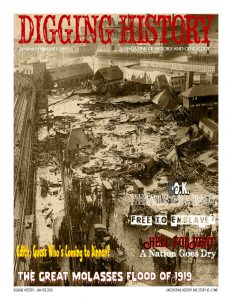 The January-February issue of Digging History Magazine explores the lead-up to the history-making event which occurred on January 16, 1919 when Nebraska voted to ratify the 18th Amendment to the United States Constitution. It was the culmination of decades (and decades) — reaching back to the 1700s of colonial America — of prohibitionists advocating for a more temperate society. One of the most famous prohibitionist was a saloon smasher (literally!) What a character she was!
The January-February issue of Digging History Magazine explores the lead-up to the history-making event which occurred on January 16, 1919 when Nebraska voted to ratify the 18th Amendment to the United States Constitution. It was the culmination of decades (and decades) — reaching back to the 1700s of colonial America — of prohibitionists advocating for a more temperate society. One of the most famous prohibitionist was a saloon smasher (literally!) What a character she was!
This year will feature several articles on the volatile year that was 1919. In so many ways events of that year changed the face of America forever. The January-February issue is on sale by individual issue purchase. Better yet, a subscription (three options to choose from) is the best value.
January 15, 1919: A Ghastly, Sticky, Deadly Mess
Boston, Massachusetts inarguably holds a revered place in American history. The city is home to numerous buildings, locations and historical markers recalling seminal events of our history as a nation. Yet, one plaque commemorating a strange and now mostly forgotten event is the subject of this first article of 2019. Why this story? A century later, in retrospect, it now seems to have portended one of the most volatile years in American history. In an attempt to chronicle the disaster – its causes and consequences – Stephen Puleo, author of Dark Tide: The Great Boston Molasses Flood of 1919, posits:
. . . the real power of the molasses flood story is what it exemplifies and represents, not just to Boston but to America. Nearly every watershed issue the country was dealing with at the time – immigration, anarchists, World War I, Prohibition, the relationship between labor and Big Business, and between the people and their government – also played a part in the decade-long story of the molasses flood. To understand the flood is to understand America of the early twentieth century.
And so, this is the first in a series of 2019 articles recalling the tumultuous year that was 1919 – and how it changed America forever.
Boston: January 15, 1919
A rumble, a hiss …. or was it a boom and a swish? Headlines trumpeting the strange, sticky, deadly disaster initially implied it was an explosion. Lawyers for United States Industrial Alcohol (USIA), parent company of Purity Distilling Company, would incessantly claim it was an explosion set off by “evilly disposed persons”. Explosion or not, the event occurring on January 15, 1919 made sure the word “molasses” remained in Boston newspapers for months to come – years, actually – as court proceedings would eventually be drawn out into the longest case in Massachusetts history.
The rest of this extensive article (complete with footnotes and sources) is featured in the January-February issue of Digging History Magazine. On sale in the magazine store, or start a subscription (three budget-minded options) and never miss an issue!
Wrapping up 2018 – Rolling into 2019
Digging History Magazine was launched in January 2018 and twelve issues were published last year. I decided to publish a free article index for anyone interested in taking a peek (all at once) at a list/synopsis of all articles. All 2018 issues are available for sale in the Magazine Store, some at reduced prices, along with the free article index.
The first issue of 2019 is also available (January-February). This year the magazine will be published bi-monthly, but still packed with articles focused on history and genealogy, This issue features articles which take a look back at events of 100 years ago. This year the magazine will feature several articles looking back at 1919, a volatile and momentous year in American history. February is Black History Month and this issue features a guest article written by the descendant of a freed slave whose legacy still matters today. Two articles on manumission and free people of color owning slaves are of interest both historically and genealogically. Feature articles include:
- The Boston Molasses Flood of 1919: could it have been an omen for the volatile year ahead for America?
- Hell for Rent: A Nation Goes Dry: On January 16, 1919 Nebraska became the 36th state to ratify the 18th Amendment to the United States Consitition. One year later, King Alcohol would be dead – or would he? A bit of history on the temperance movement, including the outrageous tactics of one well-known “saloon smasher” who made a name for herself in the early twentieth century.
- Edith, Guess Who’s Coming to Dinner: Theodore Roosevelt unexpectedly became President of the United States in 1901, following the assassination attempt and death of President William McKinley. T.R. wasn’t too far into his presidency before a long-forgotten incident occurred. It seemed innocent enough at the time, but would generate a firestorm of criticism, especially from Southern Democrats who already didn’t trust him.
- The Life of James Clemens – From Slavery to Unspoken Greatness: This issue features a guest submission from one of the descendants of James Clemens, a freed slave who went on to participate in the Underground Railroad movement. His story still matters even today.
- Manumission: Free at Last (or perhaps not) – This extensive article explores the subject of manumission of slaves. A bit of history and stories of controversial manumissions (they all seemed to be controversial). Mathews v. Springer was a precedent-setting case in post-Civil War Mississippi.
- Free to Enslave? is a look at a few incidences of free persons of color owning slaves. One of the featured characters, William “April” Ellison, was at one time the largest slave owner in South Carolina, and a cruel one at that. Milly Pierce’s story is a bit more hopeful, but it’s a piece of African American history that sometimes gets overlooked.
- Jaybird-Woodpecker War: This long-running feud in Fort Bend County, Texas had nothing to do with birds of any feather – rather, it was an all-out race war which stretched into the 1950s.
- What’s in a Name? Sometimes you just have to do a little digging when something piques your curiosity. Such was the case with an unusual name given (Seawillow) to a girl born in the middle of a torrential rain storm in 1855.
- OK: Everything Has a History – even the word we use millions of times a day: O.K. It was part of a silly nineteenth century fad, but yet endured.
- America Waldo Bogle: It wasn’t easy being a person of color in Oregon Territory. America Waldo Bogle’s story is a story of perservering and succeeding despite racial tensions.
- Preview issue here
Sarah E. Goode
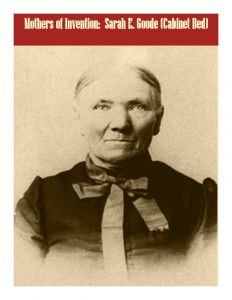 She was born Sarah Jacobs to parents Oliver and Harriet Jacobs of Toledo, Ohio in approximately 1855. The family was enumerated in the 1860 Census in Toledo and listed as being of the Mulatto race, and Oliver was a carpenter. By 1870 the family had migrated to Chicago where Oliver was still employed as a carpenter. Sarah was fifteen years old that year and by the 1880 census she had married Archibald Goode, he employed as a stair builder.
She was born Sarah Jacobs to parents Oliver and Harriet Jacobs of Toledo, Ohio in approximately 1855. The family was enumerated in the 1860 Census in Toledo and listed as being of the Mulatto race, and Oliver was a carpenter. By 1870 the family had migrated to Chicago where Oliver was still employed as a carpenter. Sarah was fifteen years old that year and by the 1880 census she had married Archibald Goode, he employed as a stair builder.
This article is no longer available for free on this site. It has been enhanced with footnotes and sources and is available for purchase in the magazine store as an Individual Article.
